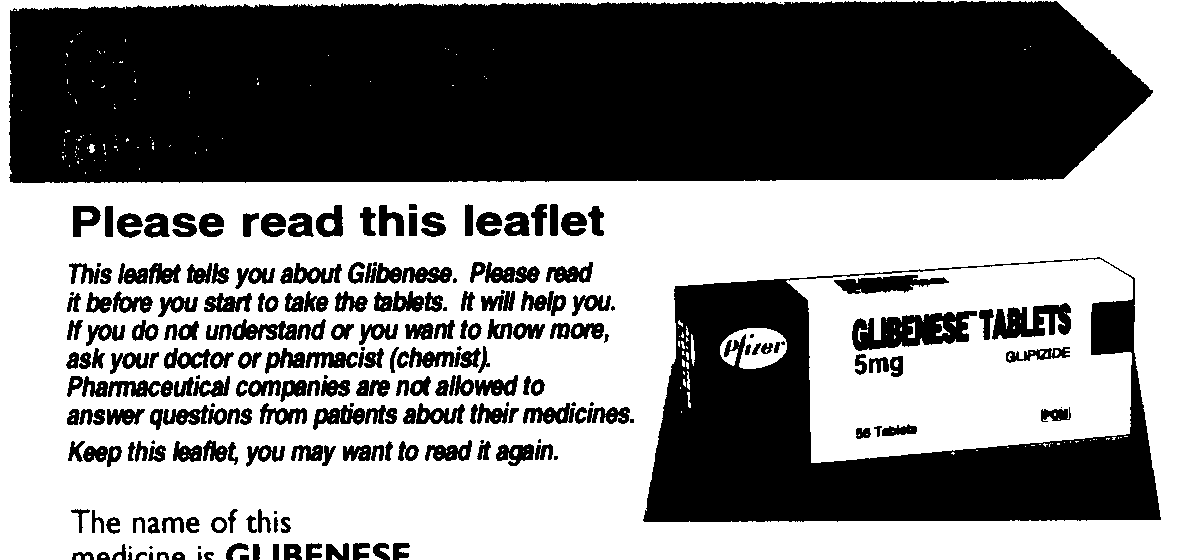
Patient Information Leaflet

What is in your medicine? Glibenese tablets are white oblong tablets with a score line across them to assist in breaking the tablets should this be necessary. Each tablet contains 5mg glipizide. The tablet also contains lactose, maize starch, microcrystalline cellulose and stearic acid. The tablets come in packs of 56 tablets Product Licence Holder and Manufacturer Pfizer Limited, Sandwich, Kent CT13 9NJ What type of medicine is Glibenese? Glibenese is one of a group of medicines called sulphonylureas. It is an antidiabetic medicine which is taken by mouth. What is your medicine for? Glibenese is used to lower blood sugar (glucose) in patients with non-insulin-dependent diabetes mellitus (NIDDM for short). This is also called maturity-onset (adult) or Type II diabetes. It is always used in conjunction with a diet which restricts sugars and fats. Before you use Glibenese Be sure to tell your doctor if
|
If any of the above applies to you this medicine may not be suitable for you to use. Your doctor will advise you. Can I drive whilst taking this medicine? All diabetic patients who drive need to be particularly careful to avoid hypoglycaemia (See section "Does your medicine cause undesirable effects"). if you are affected do not drive or operate machinery. Can Glibenese be taken with other medicines? A number of medicines may interact with Glibenese and affect diabetic control. You should tell your doctor if you are taking any of these medicines or any other medicines which you are unsure about
(used to treat muscle and joint pain)
(used as a pain killer).
(used to treat bacterial infections)
(used to prevent blood clots).
(used to treat depression)
(used to treat psychiatric conditions)
(used to treat patients with low production of thyroid hormones).
|

MORE INFORMATION ON GLIBENESE
How to take your medicine Glibenese should only be taken by mouth. It is important that you take your tablets according to the instructions of your doctor. These will be written on the label of the pack. Do not take more Glibenese than your doctor has recommended. The following dosage recommendations are only guidelines. The usual starting dose is one 5mg tablet taken approximately ½ hour before breakfast or the midday meal. If you are elderly, have mild diabetes or suffer from liver or kidney problems you may be started on 2.5mg daily. If your doctor feels your dose needs to be increased, he will instruct you to adjust the dose in small increments - usually in 2.5 - 5mg steps. The maximum recommended dose is 40mg daily. The label on the pack will tell you what dose YOU should take and how often to take it. If you are still not sure, ask your doctor or pharmacist Do not stop taking the tablets or adjust your dosage without seeing your doctor. Stopping the medicine may make the diabetes worse. What if you take too many tablets? If you accidentally take too many tablets seek medical advice immediately. If you suffer faintness, confusion, sweating or shaking these may be symptoms of low blood sugar. You should eat or drink something sugary. If fits or loss of consciousness occur, call urgently for medical assistance. What if you miss a tablet? If you miss a tablet take one before your next meal. Does your medicine cause undesirable effects? The most common effect is low blood sugar (hypoglycaemia), in rare cases this can be serious. Hypoglycaemia may cause faintness, sweating, shaking, weakness and confusion. It may be due to lack of food or too high a dose of the medicine. It can be put right by eating or drinking something sugary. If this occurs you should tell your doctor. |
If you suffer any of the effects listed below tell your doctor if they are troublesome, severe, or do not wear off as treatment goes on:
The following effects have occurred in patients being given this medicine, but they may not be due to the drug
The following effect is very rare and you should check with your doctor as soon possible if it occurs:
SERIOUS UNDESIRABLE EFFECTS ARE RARE. Hypersensitivity effects A few patients are allergic to medicines. This may cause sudden wheeziness, rash or itching all over the body. If any of these effects occur when you take Glibenese you should check with your doctor immediately. It is important to tell your doctor or pharmacist if you suffer any other undesirable effects which are not listed above. Look after your medicine This treatment is for YOU. Do not give it to others. It may not suit them. Do not take this medicine after the date stamped on the pack. Where to keep your medicine
Further information This leaflet does not contain all the information about this medicine. If you have any questions or are not sure about anything, ask your doctor or pharmacist The information in this leaflet is about Glibenese only. Date Glibenese leaflet United Kingdom last revised - August 1995 © Pfizer Limited 1995 |
